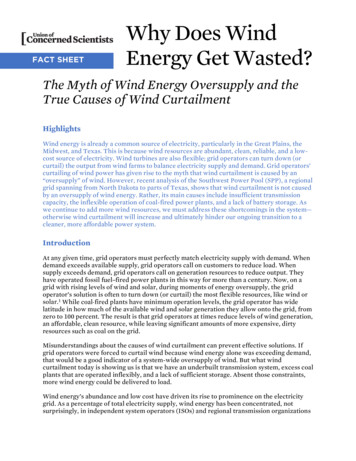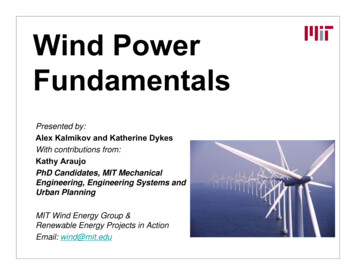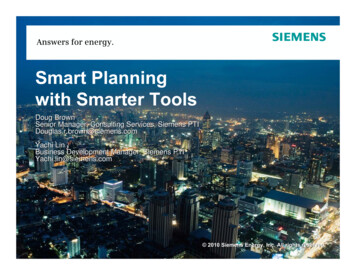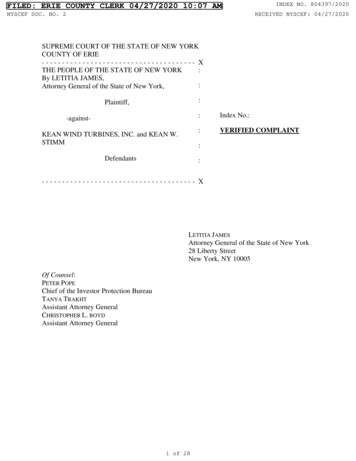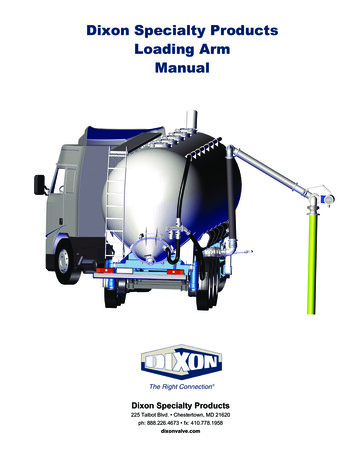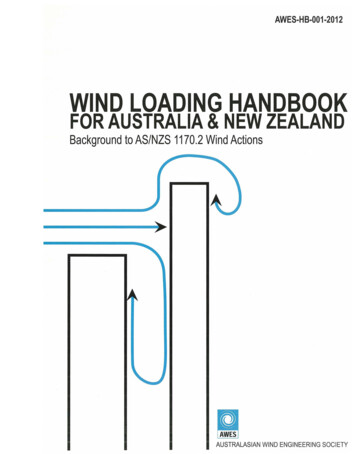
Transcription
AWES-HB-001-2012WIND LOADING HANDBOOKFOR AUSTRALIA & NEW ZEALANDBackground to AS/NZS 1170.2 Wind ActionsgAUSTRALASIAN WIND ENGINEERING SOCIETY
AWES-HB-001-2012WIND LOADING HANDBOOK FOR AUSTRALIAAND NEW ZEALANDBackground to AS/NZS 1170.2 Wind ActionsbyJ.D. Holmes, K.C.S. Kwok and J.D. Gingerwith contributions from:A.P. Jeary, C. Leitch, W.H. Melbourne, P. Mullins, L. Noicos,P. Russell, A.W. Rofail, N. Truong and G.S. WoodAUSTRALASIAN WIND ENGINEERING SOCIETY, 2012
2Published 2012 Australasian Wind Engineering Society(www.awes.org)Printed by:University Publishing ServiceThe University of SydneyAll rights strictly reserved. No part of this book may be reproducedwithout the permission of the publisherDewey decimal classification: 624.175ISBN: 978-0-9750376-1-4
3PrefaceRecent wind events in Australia and overseas have caused catastrophicresults in those affected areas, with deaths being reported as well aswidespread destruction. Research and information gathered from theseevents have been incorporated into the latest edition of AS/NZS 1170.2 -2011 to now represent a more realistic determination of wind actions.The Standard applies to structures ranging from 'the less sensitive towind action to those for which dynamic response must be taken intoconsideration'.This Handbook was prepared by the AWES to provide backgroundinformation into wind and its actions, but also into the derivation of theStandard and its contents. It covers items such as: Nature of wind loading Wind speeds and multipliers Shape factors for structures Dynamic responseIn particular, it equips users with a better understanding of wind and theStandard to provide them with improved interpretation and judgment indetermining wind actions on structures.Equally important, it enables the user to extend the Standard limitationswhile still complying with regulations, albeit other information may benecessary.It must be borne in mind: the user is ultimately responsible for theirdesign, notwithstanding the Standard, and this Handbook exists to assistthe user as far as practicable to discharge those responsibilities in thebest interests of the project, the owner and the community.Leo NoicosBEng, FIEAust, CPEng, NPER, RPEQSenior Principal Structural EngineerURS Australia Pty. Ltd.
4Disclaimer:While all due care has been taken in the collection and preparation ofinformation in this Handbook, no responsibility is assumed by the Australasian WindEngineering Society, or the individual authors or contributors, for any consequences arisingfrom the use of it.The authors acknowle dge the indirect contributions of other membersof sub-Committee 80006-02 of Standards Australia/Standards New Zealand, not listed asauthors or contributors on the first page, and the assistance of Steve Cochard (University ofSydney) during the production process for this book.Acknowledgements:
5TABLE OF CONTENTS1.Introduction, History and Scope1.1 Introduction1.2 Nature of wind loading1.3 History of Australian and New Zealand Standards on wind loading1.3.1 History of Australian Standards1.3.2 Previous New Zealand Standards1.4 Scope, and determination of wind actions1.5 Uncertainties in estimation of wind loading1.6 Design wind pressures, forces and load cases1.6.1 Design wind pressures1.6.2 Wind directions1.6.3 Frictional drag1.6.4 Ultimate and serviceability limit states1.6.5 Fatigue1.6.6 Torsion1.7 Windborne debris2.Wind Speeds and Multipliers2.1 Description of extreme wind types2.2 Types of wind speeds used in AS/NZS 1170.22.3 Importance levels and average recurrence intervals2.4 Regional wind speeds and direction multipliers2.4.1 Regional wind speeds2.4.2 Effect of recording instrument2.4.3 Wind direction multipliers (Md)2.4.4 Cyclone categories and importance levels2.4.5 Wind speeds for other jurisdictions2.5 Terrain categories and terrain-height multipliers2.5.1 Terrain categories2.5.2 Terrain-height multipliers for synoptic winds (Mz,cat)2.5.3 Terrain-height multipliers in cyclonic regions (.Mz,cat)2.6 Shielding multiplier2.7 Topographic and hill-shape multipliers2.7.1 Site elevation2.7.2 Hill-shape multiplier (Mh)2.7.3 Lee-effect multiplier 283031313233363738383839
63.4.Aerodynamic shape factors for enclosed buildings413.1 General3.1.1 Load fluctuations3.1.2 The quasi-steady assumption in AS/NZS 1170.23.1.3 Duration of wind loads3.2 Internal pressures (Cp)3.2.1 Dominant openings3.2.2 Size of dominant opening and internal volume3.2.3 Internal walls and ceilings3.3 External pressures on rectangular enclosed buildings3.3.1 External pressure coefficients (Cp,e)3.4 Adjustment factors3.4.1 Area reduction factor (Ka) for roofs and side walls3.4.2 Action combination factor (Kc)414143444546474949505151513.4.3 Local pressure factor (Ke)3.4.4 Permeable cladding reduction factor for roofs and side walls (Kp)3.5 Frictional drag (Cj)3.6 Attachments to buildings3.6.1 Solar panels attached to roofs3.6.2 Balconies and balustrades3.6.3 Sunshades3.6.4 Parapets5253535354555557Shape Factors for Other Structures594.1 Other enclosed structures59594.1.1 Multi-span buildings4.1.2 Curved roofs594.1.3 Bins, silos and tanks604.2 Free-standing walls, hoardings and roofs61614.2.1 Walls and hoardings.4.2.1 Free roofs and canopies624.2.3 Attached canopies, awnings and carports624.3 Cantilevered stadium roofs634.4 Structural members, building frames, cylindrical sections and lattice towers 65654.4.1 Open-frame structures654.4.2 Rounded cylindrical shapes674.4.3 Sharp-edged cross sections4.4.4 Lattice towers and frameworks674.4.5 Ancillaries on lattice towers69694.5 Permeable (shadecloth) structures704.6 The role of wind-tunnel tests
75.Dynamic response factors and wind-induced vibrations715.1Introduction715.2Dynamic properties of structures725.2.15.372Natural frequencies5.2.2 Structural damping735.2.3 Aerodynamic damping74Along-wind response of tall buildings and structures755.3.1Introduction755.3.2Derivation of a simple gust loading factor formula765.3.3Dynamic response factor in AS/ NZS 1170.2(Cdyn)815.3.4 Alternative evaluation of the along-wind response of tall structures bythe ESWL method5.4Cross-wind response mechanisms5.4.1Cross-wind excitation due to incident turbulence82',84855.4.2 Wake excitation855.4.3Cross-wind excitation due to cross-wind motions875.4.4Galloping excitation875.4.5 Lock-in effects885.5Cross-wind response ofbuildings885.6Cross-wind response of circular chimneys, masts and poles905.75.6.1Basics905.6.2Sinusoidal model of cross-wind response925.6.3Random vibration modelInterference effects5.7.1Interference effects on tall buildings5.7.2Interference effects on vibration of slender towers and masts5.8Combination of along- and cross-wind response5.9Occupant perception of motion and acceleration criteriaAppendix A: Structural Damping9395969799100103AlIntroduction103A2Damping measurements and physical mechanisms103A3Predictors of damping104Appendix B:References and Bibliography109
8
91: INTRODUCTION, HISTORY AND SCOPE1.1INTRODUCTIONThis Handbook is intended to support and supplement the Australian/New ZealandStandard for Wind Actions, AS/NZSthe Standard.1170.2:2011.It provides background for the clauses inIn addition, it provides additional information on shape factors and dynamicfactors, such as structural damping, - i.e. information that is compatible with, but notprovided in, the Standard itself.HandbookdoesmorethanAlthough it performs the functions of a commentary, respondence with the Standard itself.This document is a successor to the 'Commentary to ASAustralian Wind Engineering Society (Holmes,performed a similar function for the1170.2-1989'published by th Melbourne and Walker,1990),which1989 Australian Standard.The Handbook is divided into the following chapters and appendices:Chapter1gives an introduction to wind loading, a history of the Standard, and includesbackground onChapterSections 1and 2 of the Standard itself.2 discusses wind speeds and multipliers incorporating1170.2.background toSections 3 and4 in AS/NZSChapter 3 provides background onrectangular enclosed buildings.Section5 in the Standard - i.e. shape factors forAdditional information for designers is given - particularlyon attachments to buildings.Chapter 4 covers shape factors for structures other than rectangular enclosed buildings, andincludes commentary on Appendices C to Fin the Standard.Chapter 5 discusses the dynamic response of structures to wind and provides background toSection 6-Dynamic response factor,in the Standard.Appendix A provides a more detailed discussion of structural damping than that given inChapter 5, and Appendix B provides a comprehensive list of references and a bibliography.References to clauses, figures, tables etc. in AS/NZS1170.2:2011are given initalicsin thisHandbook. References to sections, figures and tables in the Handbook are not in italics.
101.2NATURE OF WIND LOADINGWind loading of structures is a complex phenomenon. The wind itself is random, beingcomposed of a multitude of eddies of varying sizes and rotational characteristics carriedalong in a general stream of air moving relative to the Earth's surface. These eddies givewind its gusty or turbulent character. In both Australia and New Zealand, extreme windscan be produced by a variety of mechanisms.In Australia, extreme winds which are important in the design of structures can be classifiedas 'synoptic' winds and small-scale thunderstorm events. Synoptic winds are produced bylarge-scale pressure systems - essentially a balance between Coriolis forces associated withthe earth's rotation, and pressure gradients. These storms may last for several days. InTasmania and the South Island of New Zealand, located in the latitudes known as the'roaring forties', gales produced by large-scale synoptic events are common.These alsoaffect the southern coastline of Australia. Along the eastern coast of New South Wales,strong winds are often produced by 'East Coast Lows' - low pressure systems in the TasmanSea.Tropical cyclones are a particular type of severe synoptic storm that occur over the tropicalocean. In the Northern Hemisphere they are also known by the names of 'hurricanes' and'typhoons'. In Australia they affect extensive lengths of the coastlines of Queensland, theNorthern Territory and Western Australia. In recent decades, information gained fromsatellite imaging, and aircraft flights in other countries, has greatly improved knowledge ofthese events. In many events, relatively little definitive information on the wind speedsproduced when tropical cyclones make landfall in Australia is available, due to thesparseness of anemometers.For synoptic winds, the gustiness of strong winds in the lower levels of the atmosphere,known as the. 'boundary layer', arises from frictional interactions with surface features suchas vegetation, buildings and water surfaces, which characterize the terrain.In the lowerlevels of the boundary layer, in which most structures are located, the wind speed averagedover time periods of ten to sixty minutes generally increases progressively with height, whilethe gustiness, or turbulence, tends to decrease with height. The average wind speeds arealso affected significantly by topography, such as hills, escarpments and ridges.Thunderstorms are driven by strong convection of warm moist air to high altitudes. Rapidcooling is accompanied by the release of latent heat. This energy re-appears as kineticenergy of falling rain, hail and cold air. The downdraft of cold air generates an outflow gustfront at ground level. The maximum gust from these events near the ground can exceed50 m/s.Along the coastal strip of south-eastern Australia, convective thunderstorms and severedowndrafts are usually associated with cold fronts.However, in northern and inlandAustralia, severe storms are produced by local convection.Although relatively little isknown about the variation of gust wind speeds with height in these events, the gust profileat time of the peak winds appears to increase slowly up to about 100 metres height,reducing in magnitude at greater heights; however, the gusts are well correlated (or
11synchronized) over large distances horizontally, resulting in significant wind loading onhorizontal, line-like structures such as transmission lines. The period of strong winds ismuch shorter than for synoptic events. An appropriate averaging time for winds inconvective downdrafts is about 1 minute. The turbulence, or gustiness, superimposed onthe average wind is lower than that for synoptic events, as the effects of terrain and surfaceroughness are much lower. Topography is also expected to have a lesser effect on windgusts from downdrafts, compared with that on synoptic winds.New Zealand, particularly in the South Island, experiences 'downslope' winds on the lee sideof the Alps. These are associated with gravity waves above the mountain peaks. They canproduce sustained winds for several hours but affect relatively small areas.When strong winds interact with a structure, pressures and forces on the surfaces of thestructure are generated. The characteristics of these pressures are influenced by thecharacteristics of the approaching wind and the geometry of the structure.Significantinternal pressures may also be generated if there are openings, or permeability, linking theexterior of a building with the interior.Pressures on structures are not steady, but highly fluctuating, partly because of thegustiness in the wind, but also because of local eddies and vortex generation at the edges ofthe structures themselves. The pressures are also not uniformly distributed spatially overthe surface of a structure.Most of the effects described in this section are incorporated into the Standard in someform or other, but mostly in an approximate, or generalized way. The complexities of windloading described here, should be kept in mind when applying a design document like theAustralian/New Zealand Standard. Due to these many uncertainties, the maximum windloads may vary from those assumed in design. It should also be noted that the actualstrength of a structure, or its elements, when constructed, may differ considerably fromthat assumed at the design stage.Thus non-failure of a structure due to wind cannotnecessarily be taken as evidence of conservatism of the wind actions Standard.1.3HISTORY OF AUSTRALIAN AND NEW ZEALAND STANDARDS ONWIND LOADING1.3.1 History of Australian StandardsAS/NZS 1170.2:2011 has a lineage that goes back forty years. Australian Standard CA34,Part II published in 1971 (Standards Association of Australia, 1971) replaced an earlierinterim document, and was the 'first modern wind loading code or standard published ineither Australia or New Zealand. Although in Imperial units, all subsequent Australian andNew Zealand Standards are directly descended from it.It contained a contour map of'regional basic wind speeds' in miles per hour with a SO-year return period (applicable tomost structures), using anemometer data analyzed by Whittingham (1964).As in allsubsequent versions, this wind speed was defined as a gust of 2-3 seconds duration
12recorded at the standard meteorological height of (33ft.) 10 m in flat open, terrain.However, recent research has found that the averaging time of the peak gust, recorded bythe Dines anemometer used at that time, was considerably less than 2-3 seconds - seeSection 2.4.2.CA34 Part II also gave a table of 'regional basic design' wind velocities for 5, 25, SO and 100year return period values for 48 cities, towns and other centres, for which the wind speedanalyses had been carried out. Values for a number of these stations were labeled 'shortrecord'. Notably, considering the event that occurred three years later, the value given forDarwin for 100-year return period was only 119 mph (53 m/s). However, a 'cyclone factor'of 1.15 was applied to all locations north of 30 S within 30 miles of the coastline. The fourterrain categories specified were essentially the same as those given in the current Standard.Shape factors (pressure and force coefficients) were all given in an Appendix and werelargely based on the British Code of Practice and Swiss Norm of the time, with valuesobtained in smooth- flow wind tunnels. However, local pressure factors of 1.5 and 2.0 werespecified in edge and corner regions - but with no tributary area restrictions. A section ondynamic response was provided, but this largely offered descriptive and reference material.AS 1170.2 - 1973 (Standards Association of Australia, 1973) was essentially a metric versionof CA34, Part II -1971, although some changes to the listed regional basic wind speeds weremade for some stations.Dynamic response of tall buildings was covered only in aninformative Annex (in fact - extracts from a conference paper by B.J. Vickery).The occurrence of Cyclone 'Tracy' at Darwin, on Christmas Day in 1974, resulted in a newversion of AS 1170.2, with a change to the map of regional basic design wind velocities. Azonal system for the cyclone-prone coastal strip of northern Australia was introduced. Alsoin the 1975 edition (Standards Association of Australia, 1975) an increased value of negativepressure coefficient for cladding elements on side walls of tall buildings was recommendedin a note. An amendment, released in 1978, introduced a new table of external pressurecoefficients for the roofs of buildings with pitches less than 10 degrees. This was laterincorporated into the 1981 edition of AS 1170.2 (Standards Association of Australia, 1981).In the 1983 edition of AS 1170.2 (Standards Association of Australia, 1983), the widely-usedtable in Appendix B of external pressure coefficients for pitched roof buildings wasextensively revised to include values obtained in turbulent flow from a boundary-layer windtunnel. In addition, an area reduction factor for roofs according to tributary area, a winddirection reduction factor, a new system of moving areas for local pressure factors andrevised rules for wind flow over escarpments, were introduced. However, the majority ofAS 1170.2-1983 was similar in format and content to CA34, Part 11-1971.The 1989 edition of AS 1170.2 (St ndards Australia, 1989) was a major revision of earlierversions. It was introduced as part of the conversion to limit states design in Australia. Italso attempted to provide an alternative simpler approach for smaller low-rise buildings,and to provide a more accurate determination of wind loads for tall structures withsignificant dynamic response. AS 1170.2-1989 consisted of three 'stand-alone' sections asfollows:
13Section 2. Simplified ProcedureSection 3. Detailed Procedure: Static AnalysisSection 4. Detailed Procedure: Dynamic AnalysisEach section had its own map of regional wind speeds (pressures in the case of theSimplified Section), and multipliers for terrain and topography. A new feature of the 1989Standard was the specification of high-return-period design wind speeds (i.e. 1000 years) forultimate limit state design. This eliminated the need for the 'cyclone factor' in earlierversions. This concept has since been adopted in the United States.The 1989 Standard also contained numerous other changes with revisions to shape factorsfor multi-span buildings, free-standing walls and roofs, and building frames reflecting theextensive research carried out in the 1970s and 1980s.The cross-wind response of tallbuildings was also incorporated in detail (possibly for the first time anywhere in the world).AS/NZS 1170.2:2002 (Standards Australia, Standards New Zealand, 2002a) was the firstcombined Australian/New Zealand wind actions Standard and was also a major revision informat compared to AS 1170.2-1989.The following major changes were also introduced in 2002: A variable annual probability of exceedence was adopted for wind speeds. Thesereplaced importance multipliers used in AS 1170.2-1989,The separate 'simplified procedure', and 'detailed procedure: dynamic analysis',used in AS 1170.2-1989 were removed, and a single design method based on a gustwind speed was adopted,Direction multipliers for wind speeds for all non-cyclonic regions were introduced,replacing directional wind speeds for capital cities only in AS 1170.2-1989,Methods based on mathematical formulae were introduced for calculation of hill shape (topographic)multipliers and for cross-wind dynamic response of tall buildings,The methods for dynamic response used for along- and cross-wind dynamicresponse in AS 1170.2-1989, were replaced with approaches based, as the rest ofthe Standard, on a peak gust wind speed.In addition, numerous smaller changes, additions and adjustments to the tables of shapefactors were incorporated.For the first time in its history, the 2002 edition of the Standard was later supplemented bya user-friendly Guide (Holmes and King, 2005), containing nine detailed examples ofapplication of the Standard to various types of structure.The 2011 edition of AS/NZS 1170.2 had a number of significant changes and additionalclauses have been incorporated. The principal changes are as follows: A torsional loading requirement in Clause 2.5.4 in the form of an eccentricity of 20%of the breadth, b, applied to the along-wind loading. This has only been prescribed
14 for tall buildings greater than 70 metres in height (see Section 1.6.6 in thisHandbook).Windborne debris impact loading criteria have been added in Clause 2.5. 7.New wording in Clause 5.3.2 requires designers to treat closed doors and windows,particularly roller doors, as potential dominant openings unless it can bedemonstrated that they are structurally capable of resisting the design wind loads.A new Clause 5.3.4 requires consideration of wind loads on internal walls andceilings.A revised version of Clause 5.4.3 concerned with the action combination factorSome changes to Clause 5.4.4 and Table 5.6 on local pressure factors.In an Amendment to AS/NZS 1170.2:2011, based on recent research on the wind profiles intropical cyclones and hurricanes, it is proposed to remove Table 4.1(8)i.e. theterrain/height multipliers in Regions C and D will be the same as those specified for RegionsA and B. Furthermore, the terrain category for over-water winds will generally be treatedas Terrain Category 1, irrespective of limit state (i.e. on the level of wind speeds), or of theregion. However, for winds blowing from an ocean fetch, the inshore region of breakingwaves may be treated as an intermediate Terrain Category lYz.-1.3.2Previous New Zealand StandardsPrior to 2002, New Zealand had separate loading Standards dated 1984 and 1992. The windloading section (Part 5) of NZS 4203:1992 (Standards New Zealand, 1992) was in fact anadaption of, and very similar to, AS 1170.2-1989.The main differences were in thedifferent treatment of topographic effects and multipliers, and the lack of a dynamicanalysis method for wind loading.However, NZS 4203:1992 referred the user to AS1170.2-1989 for the latter.In 2002, in co mmon with many other standards, a combined Australia-New Zealand WindActions Standard was published. The use of common standards has resulted from theCloser Economic Relations (CER) free trade agreement between the two countries datingback to the 1980s.The seven wind regions for New Zealand in NZS 4203:1992 weresimplified to three regions in AS/NZS 1170.2:2002. Also the 'limit-state multipliers' used inNZS 4203, to adjust wind speeds for serviceability and ultimate limit states, wereInstead average recurrence intervals were used in AS/NZS 1170.0:2002discontinued.(Section 3) as a basis for determining regional wind speeds for design in New Zealand.1.4 SCOPEJ AND DETERMINATION OF WIND ACTIONSClause 1.1 of the Standard limits the coverage to buildings less than 200m in height and roofspans less than lOOm. 'Roof spans' should be interpreted as 'unsupported roof spans'. Inthe case of tall buildings greater than 200 metres in height, the dynamic effects are moresignificant and complex than can be handled by the Standard. In both these cases, wind tunnel studies and related processing is normal practice. Offshore structures, bridges andtransmission line towers are also excluded. In the case of the last two, separate Australian
15and New Zealand standards which incorporate wind load information are available. In thecase of bridges in Australia, the Bridge Design Standard is AS 5100 (Standards Australia,2004). For overhead line design, an Australian - New Zealand Standard, AS/NZS 7000:2010was issued in 2010 (Standards Australia/Standards New Zealand, 2010).The effects of tornados are also excluded in Clause 1.1. In Australia, only about sixteenconfirmed tornados occur on average each year, over the whole country. The risk of adirect strike on an individual structure is minimal; however a structure designed to satisfyAS/NZS 1170.2 should perform satisfactorily in weaker tornados - i.e. Categories Fl and F2on the Fujita scale.Direct application of AS/NZS 1170.2 is one method of determination of wind actions, and isthe recommended method by the Building Code of Australia. However, there are otheralternative paths, or 'special studies', that provide an equivalent level of confidence, and areregarded as acceptable: Reliable references used consistently with the clauses of AS/NZS 1170.2.Reliable data on wind speed and direction corrected for the influence of terrain,topography and neighbouring buildings where necessary, including a detailedprobabilistic analysis for the effects of wind direction.Wind tunnel tests carried out for a specific structure, or reference to such tests on asimilar structure, together with applicable clauses in AS/NZS 1170.2.Calculations by computational fluid dynamics, which have been calibrated againstfull-scale or wind-tunnel measurements.Wind-tunnel testing in Australia and New Zealand should normally follow the procedures ofthe Quality Assurance Manual of the Australasian Wind Engineering Society (AWES, 2001).In particular, wind-tunnel testing to determine the effects of synoptic winds shall ensurethat the appropriate terrain categories are modelled, and the variation of wind speed withheight, and the scale and intensity of turbulence are modelled with reasonable accuracy.Where curved shapes are involved, the effects of Reynolds number should be taken intoaccount (this usually excludes the use of model-scale testing at low wind speeds forstructures with circular cross sections, such as chimneys). Measurement systems for forceand pressure should have appropriate frequency-response characteristics. When a high frequency force balance approach is used for tall buildings, state-of-the art methods formode shape correction and assessment of torsional response should be adopted. Whenmodelling is adopted to directly determine resonant dynamic response and/or aeroelasticeffects, appropriate scaling of mass, stiffness and structural damping should be adopted.Finally, when internal pressures are included in studies for buildings, appropriate scaling ofinternal volumes should be adopted (Holmes, 2006; Sharma et al., 2010).Wind-tunnel tests are also often carried out for cases that are covered in the Standard.Such tests can generally be expected to give lower design wind loads than the Standard.However, even if that is not the case, the results from the wind-tunnel studies should beused in preference to the values from the Standard.
161.5 UNCERTAINTIES IN ESTIMATION OF WIND LOADINGIn the determination of wind loads, various parameters are combined - regional windspeeds, multipliers for terrain, topography and shielding, aerodynamic shape factors, and insome cases, a dynamic response factor. Table 1.1 gives estimations of the coefficients ofvariation for these variables.Table 1.1. Estimated coefficients of variation for parameters used in AS/NZS 1170.2VisParameterVRMdMz,catMsMtCfigCdynRegion A0.070.050.100.200.150.150.10VsooOther Regions0.120.050.100.200.100.150.10Region A0.120.050.100.200.150.150.10Other Regions0.200.050.100.200.100.150.10The greater uncertainty for the regional wind speeds ( VR) for Regions B, C and D reflects thefact that tropical cyclones are generally too infrequent for analyses of anemometer data tobe able to make accurate predictions. There is more uncertainty in the specified values oftopographic multipliers in Region A, because of the uncertain effects of topography onwinds at ground level produced by thunderstorm downdrafts and outflows.The general problems of codification for various aspects of wind loads, and the variationsbetween national and international codes and standards were discussed in a series ofpapers by Holmes et al., {2005a), Tamura et al. (2005b), Holmes et al. (2005b), Letchford etal. (2005), and Kaspersky and Geurts (2005).1.6DESIGN WIND PRESSURES, FORCES AND LOAD CASES1.6.1 Design wind pressuresEquation 2.4(1) in the Standard is the basic equation for design wind pressures acting on abuilding surface (external or internal). This equation is reproduced in Eqn. (1.1).(1.1)In this equation, the dynamic wind pressure (0.5pairHVdes,ri/2 represents the additionalpressure generated when the wind flow is brought to rest at a point in the flow, without thedisturbance produced by a large bluff body, - it results from the conversion of momentumin the flow to a force per unit area, and essentially it is a statement of Newton's Second Law.
173The value of air density, Pain of 1.20 kg/m , specified in Clause 2.4.2 of the Standard, is anaverage value based on a temperature of 21 C, and typical atmospheric pressure at sealevel.Locations at high altitudes such as alpine areas have lower atmospheric pressurewhich would lead to lower air densities, but they also tend to have a lower temperaturethan sites at sea level - this is a compensatory factor.Buildings and most other ground-based structur
5.3.4 Alternative evaluation of the along-wind response of tall structures by the ESWL method 82 5.4 Cross-wind response mechanisms 84 ', 85 85 87 87 88 5.4.1 Cross-wind excitation due to incident turbulence 5.4.2 Wake excitation 5.4.3 Cross-wind excitation due to cross-wind


